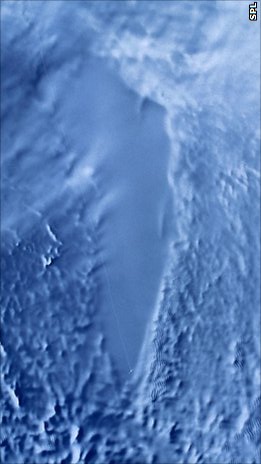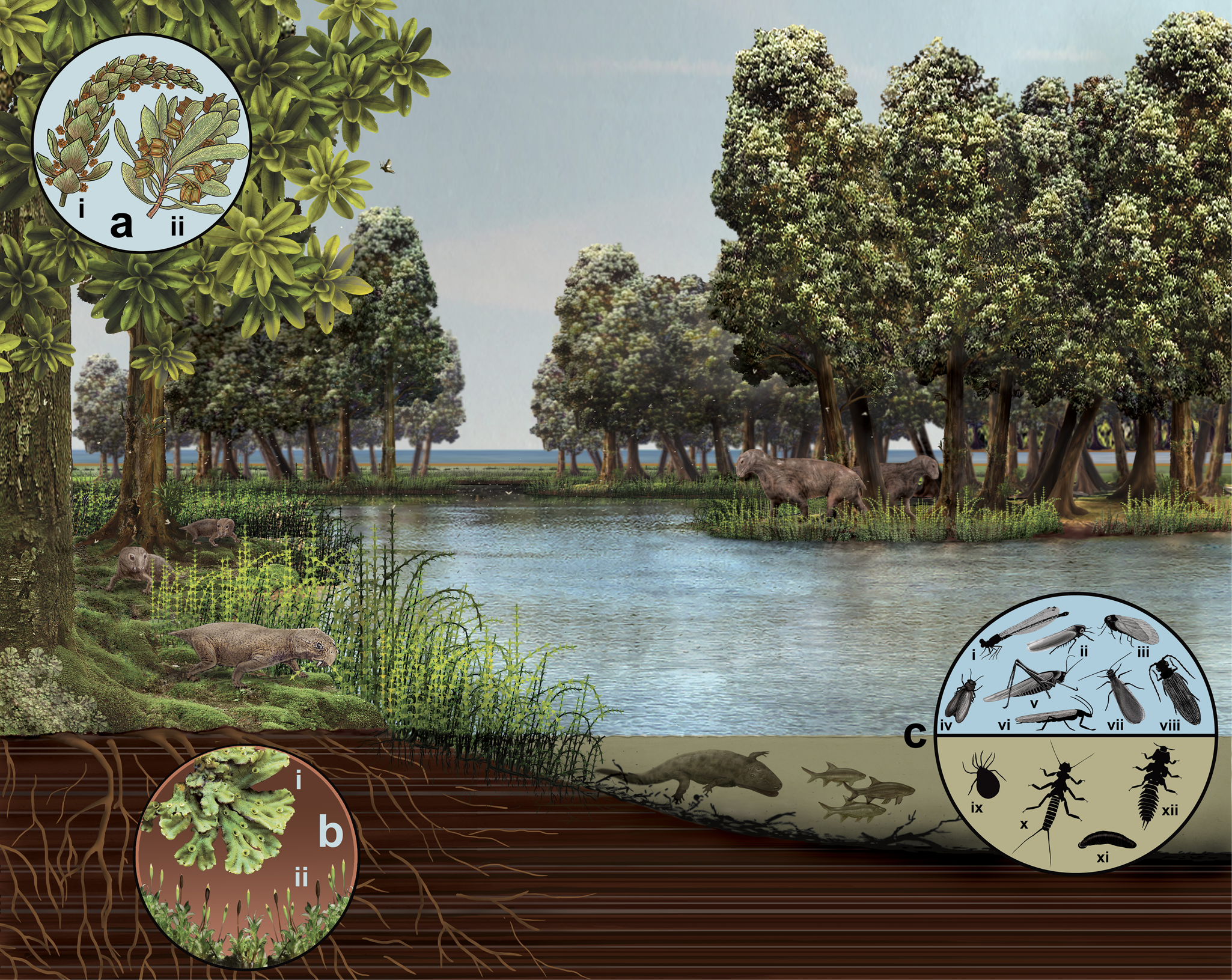|
Radok Lake
Radok Lake is a meltwater lake about long and marked by a slender glacier tongue feeding into it from the west, lying south-west of Beaver Lake and south-east of the Aramis Range, Prince Charles Mountains. It was plotted by Australian National Antarctic Research Expeditions (ANARE) from air photos taken by the RAAF Antarctic Flight in 1956. The lake was named for Uwe Radok, Reader (head) of Meteorology Department at the University of Melbourne, who greatly assisted Australian National Antarctic Research Expeditions (ANARE)'s glaciological program. With a depth of , Radok Lake is the deepest known surface lake on the Antarctic continent (whereas Lake Vostok is the continent's deepest subglacial lake) and the only known freshwater lake to host a floating ice tongue glacier (the Battye Glacier). It is drained by Pagodroma Gorge in to Beaver Lake. Radok Lake is an isothermal and non-stratified Lake, i.e. homogeneous water body. Bainmedart Cove () is a cove about long in east ... [...More Info...] [...Related Items...] OR: [Wikipedia] [Google] [Baidu] |
Antarctica
Antarctica () is Earth's southernmost and least-populated continent. Situated almost entirely south of the Antarctic Circle and surrounded by the Southern Ocean (also known as the Antarctic Ocean), it contains the geographic South Pole. Antarctica is the fifth-largest continent, being about 40% larger than Europe, and has an area of . Most of Antarctica is covered by the Antarctic ice sheet, with an average thickness of . Antarctica is, on average, the coldest, driest, and windiest of the continents, and it has the highest average elevation. It is mainly a polar desert, with annual Climate of Antarctica#Precipitation, precipitation of over along the coast and far less inland. About 70% of the world's freshwater reserves are frozen in Antarctica, which, if melted, would raise global sea levels by almost . Antarctica holds the record for the Lowest temperature recorded on Earth, lowest measured temperature on Earth, . The coastal regions can reach temperatures over in the ... [...More Info...] [...Related Items...] OR: [Wikipedia] [Google] [Baidu] |
Subglacial Lake
A subglacial lake is a lake that is found under a glacier, typically beneath an ice cap or ice sheet. Subglacial lakes form at the boundary between ice and the underlying bedrock, where liquid water can exist above the lower melting point of ice under high pressure. Over time, the overlying ice gradually melts at a rate of a few millimeters per year. Meltwater flows from regions of high to low hydraulic pressure under the ice and pools, creating a body of liquid water that can be isolated from the external environment for millions of years. Since the first discoveries of subglacial lakes under the Antarctic Ice Sheet, more than 400 subglacial lakes have been discovered in Antarctica, beneath the Greenland Ice Sheet, and under Iceland's Vatnajökull ice cap. Subglacial lakes contain a substantial proportion of Earth's liquid freshwater, with the volume of Antarctic subglacial lakes alone estimated to be about 10,000 km3, or about 15% of all liquid freshwater on Earth. As ... [...More Info...] [...Related Items...] OR: [Wikipedia] [Google] [Baidu] |
Scientific Committee On Antarctic Research
The Scientific Committee on Antarctic Research (SCAR) is an interdisciplinary body of the International Science Council, International Science Council (ISC). SCAR coordinates international scientific research efforts in Antarctica, including the Southern Ocean. SCAR's scientific work is administered through several discipline-themed ''science groups''. The organisation has observer status at, and provides independent advice to Antarctic Treaty System, Antarctic Treaty Consultative Meetings, and also provides information to other international bodies such as the Intergovernmental Panel on Climate Change, Intergovernmental Panel on Climate Change (IPCC) and the United Nations Framework Convention on Climate Change, United Nations Framework Convention on Climate Change (UNFCCC). History At the International Council for Science, International Council of Scientific Unions (ICSU)'s Antarctic meeting held in Stockholm from 9–11 September 1957, it was agreed that a committee should b ... [...More Info...] [...Related Items...] OR: [Wikipedia] [Google] [Baidu] |
Australian Antarctic Data Centre
The Australian Antarctic Data Centre is a section of the Australian Antarctic Division, which forms part of the Australian Government, Commonwealth of Australia, in the Department of the Environment and Energy. AADC services form the backbone of data collection and data management in Australia's Antarctic Science Program. Services * Managing science data from Australia's Antarctic research (acquiring, indexing, storing, disseminating, linking and data mining) * Mapping Australia's areas of interest in the Antarctic region * Managing Australia's Antarctic state of the environment reporting * Fabricating, installing and managing Australia's Antarctic station tide gauge A tide gauge is a device for measuring the change in sea level relative to a vertical datum. It is also known as a mareograph, marigraph, and sea-level recorder. When applied to freshwater continental water body, water bodies, the instrument may ...s * Providing advice and education and a range of other produc ... [...More Info...] [...Related Items...] OR: [Wikipedia] [Google] [Baidu] |
USGS
The United States Geological Survey (USGS), founded as the Geological Survey, is an government agency, agency of the United States Department of the Interior, U.S. Department of the Interior whose work spans the disciplines of biology, geography, geology, and hydrology. The agency was founded on March 3, 1879, to study the landscape of the United States, its natural resources, and the natural hazards that threaten it. The agency also makes maps of planets and moons, based on data from List of NASA missions, U.S. space probes. The sole scientific agency of the U.S. Department of the Interior, USGS is a fact-finding research organization with no regulatory responsibility. It is headquartered in Reston, Virginia, with major offices near Lakewood, Colorado; at the Denver Federal Center; and in NASA Research Park in California. In 2009, it employed about 8,670 people. The current motto of the USGS, in use since August 1997, is "science for a changing world". The agency's previous s ... [...More Info...] [...Related Items...] OR: [Wikipedia] [Google] [Baidu] |
Glossopteris
''Glossopteris'' (etymology: from Ancient Greek γλῶσσα (glôssa, " tongue ") + πτερίς (pterís, " fern ")) is the largest and best-known genus of the extinct Permian order of seed plants known as Glossopteridales (also known as Arberiales, Ottokariales, or Dictyopteridiales). The name ''Glossopteris'' refers only to leaves, within the framework of form genera used in paleobotany, used for leaves of plants belonging to the glossopterid family Dictyopteridiaceae. Species of ''Glossopteris'' were the dominant trees of the middle to high-latitude lowland vegetation, often in swampy environments, across Gondwana (which at this time formed the southern part of Pangaea) during the Permian Period. ''Glossopteris'' fossils were critical in recognizing former connections between the various fragments of Gondwana: South America, Africa, India, Australia, New Zealand, and Antarctica. The ''Glossopteris'' forest ecosystems became extinct as part of the end-Permian mass ... [...More Info...] [...Related Items...] OR: [Wikipedia] [Google] [Baidu] |
Bainmedart Cove
Radok Lake is a meltwater lake about long and marked by a slender glacier tongue feeding into it from the west, lying south-west of Beaver Lake and south-east of the Aramis Range, Prince Charles Mountains. It was plotted by Australian National Antarctic Research Expeditions (ANARE) from air photos taken by the RAAF Antarctic Flight in 1956. The lake was named for Uwe Radok, Reader (head) of Meteorology Department at the University of Melbourne, who greatly assisted Australian National Antarctic Research Expeditions (ANARE)'s glaciological program. With a depth of , Radok Lake is the deepest known surface lake on the Antarctic continent (whereas Lake Vostok is the continent's deepest subglacial lake) and the only known freshwater lake to host a floating ice tongue glacier (the Battye Glacier). It is drained by Pagodroma Gorge in to Beaver Lake. Radok Lake is an isothermal and non-stratified Lake, i.e. homogeneous water body. Bainmedart Cove () is a cove about long in east ... [...More Info...] [...Related Items...] OR: [Wikipedia] [Google] [Baidu] |
Sandstone
Sandstone is a Clastic rock#Sedimentary clastic rocks, clastic sedimentary rock composed mainly of grain size, sand-sized (0.0625 to 2 mm) silicate mineral, silicate grains, Cementation (geology), cemented together by another mineral. Sandstones comprise about 20–25% of all sedimentary rocks. Most sandstone is composed of quartz or feldspar, because they are the most resistant minerals to the weathering processes at the Earth's surface. Like uncemented sand, sandstone may be imparted any color by impurities within the minerals, but the most common colors are tan, brown, yellow, red, grey, pink, white, and black. Because sandstone beds can form highly visible cliffs and other topography, topographic features, certain colors of sandstone have become strongly identified with certain regions, such as the red rock deserts of Arches National Park and other areas of the Southwestern United States, American Southwest. Rock formations composed of sandstone usually allow the p ... [...More Info...] [...Related Items...] OR: [Wikipedia] [Google] [Baidu] |
Snow Petrel
The snow petrel (''Pagodroma nivea'') is the only member of the genus ''Pagodroma.'' It is one of only three birds that have been seen at the Geographic South Pole, along with the Antarctic petrel and the south polar skua, which has the most southerly breeding sites of any bird, inland in Antarctica. Taxonomy The snow petrel was species description, described in 1777 by the German naturalist Georg Forster in his book ''A Voyage Round the World''. He had accompanied James Cook on Cook's Second voyage of James Cook, second voyage to the Pacific. We particularly observed a petrel, about the size of a pigeon, entirely white, with a black bill and blueish feet; it constantly appeared about the icy masses, and may be looked upon as a sure fore-runner of ice. Forster placed the snow petrel in the genus ''Procellaria'' that had been erected for the petrels by Carl Linnaeus in 1758 and coined the binomial name ''Procellaria nivea''. The snow petrel is now the only species placed in the ... [...More Info...] [...Related Items...] OR: [Wikipedia] [Google] [Baidu] |
Geologist
A geologist is a scientist who studies the structure, composition, and History of Earth, history of Earth. Geologists incorporate techniques from physics, chemistry, biology, mathematics, and geography to perform research in the Field research, field and the laboratory. Geologists work in the Energy industry, energy and mining sectors to exploit Natural resource, natural resources. They monitor environmental hazards such as earthquakes, volcanoes, tsunamis and landslides. Geologists are also important contributors to climate change discussions. History James Hutton is often viewed as the first modern geologist. In 1785 he presented a paper entitled ''Theory of the Earth'' to the Royal Society of Edinburgh. In his paper, he explained his theory that the Earth must be much older than had previously been supposed to allow enough time for mountains to be eroded and for sediments to form new rocks at the bottom of the sea, which in turn were raised up to become dry land. Hutton pub ... [...More Info...] [...Related Items...] OR: [Wikipedia] [Google] [Baidu] |
Gorge
A canyon (; archaic British English spelling: ''cañon''), gorge or chasm, is a deep cleft between escarpments or cliffs resulting from weathering and the erosion, erosive activity of a river over geologic time scales. Rivers have a natural tendency to cut through underlying surfaces, eventually wearing away rock layers as sediments are removed downstream. A river bed will gradually reach a baseline elevation, which is the same elevation as the body of water into which the river drains. The processes of weathering and erosion will form canyons when the river's River source, headwaters and estuary are at significantly different elevations, particularly through regions where softer rock layers are intermingled with harder layers more resistant to weathering. A canyon may also refer to a rift between two mountain peaks, such as those in ranges including the Rocky Mountains, the Alps, the Himalayas or the Andes. Usually, a river or stream carves out such splits between mountains. Exa ... [...More Info...] [...Related Items...] OR: [Wikipedia] [Google] [Baidu] |
Cove
A cove is a small bay or coastal inlet. They usually have narrow, restricted entrances, are often circular or oval, and are often situated within a larger bay. Small, narrow, sheltered bays, inlets, creek (tidal), creeks, or recesses in a coast are often considered coves. Colloquially, the term can be used to describe a sheltered bay. Geomorphology describes coves as precipitously walled and rounded cirque-like openings like a valley extending into or down a mountainside, or in a hollow or nook of a cliff or steep mountainside. A cove can also refer to a corner, nook, or cranny, either in a river, road, or wall, especially where the wall meets the floor. Formation Coves are formed by differential erosion, which occurs when softer rocks are worn away faster than the harder rocks surrounding them. These rocks further erode to form a circular bay with a narrow entrance, called a ''cove''. Another way is that waves can transport rocks and sediment towards cliffs or rock faces, whic ... [...More Info...] [...Related Items...] OR: [Wikipedia] [Google] [Baidu] |









